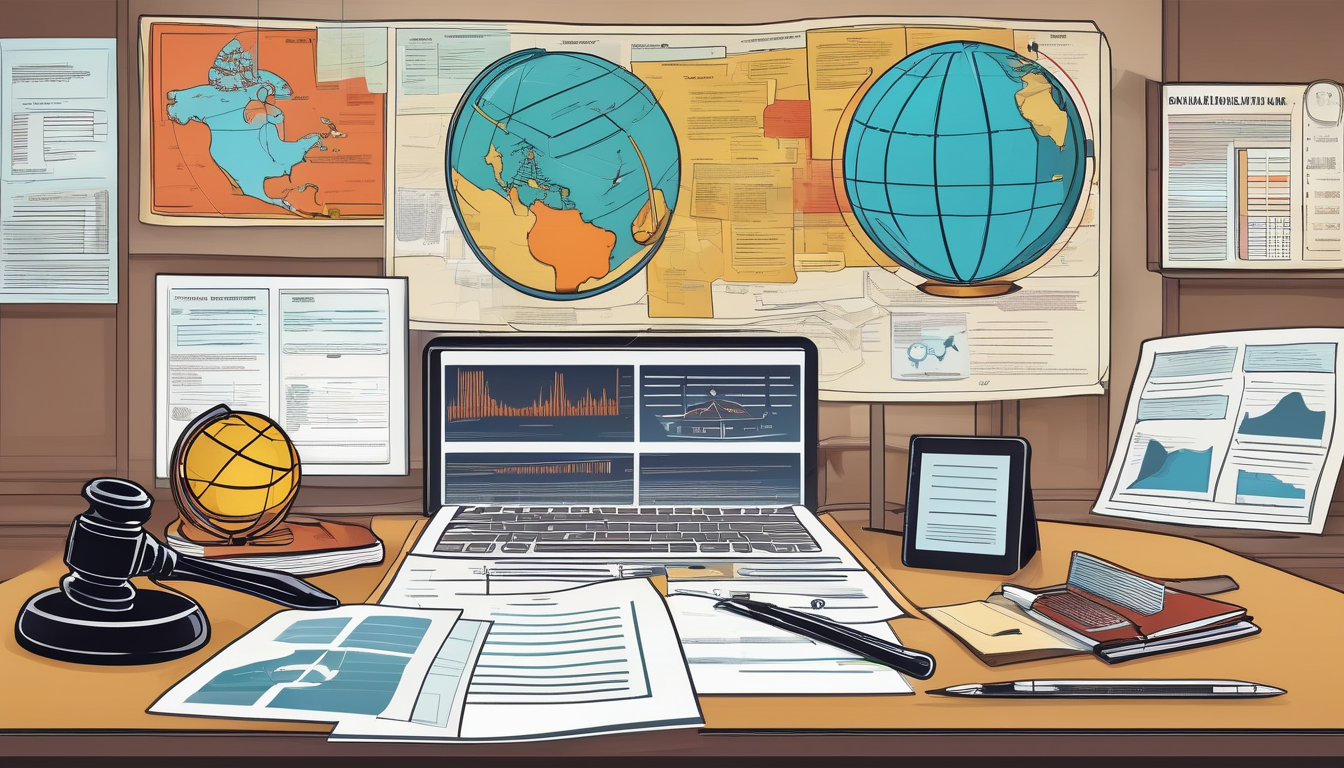The world of artificial intelligence (AI) is evolving at an astonishing pace, and with this rapid development comes a whirlwind of discussions around regulation and security measures. As we dive deeper into the digital age, the question arises: how do we ensure that AI serves humanity without compromising our values or safety? This debate is not merely academic; it resonates with every individual, organization, and government. The implications of unregulated AI could be catastrophic, akin to letting a child play with fire without supervision.
On one hand, there is a pressing need for regulation. Unchecked AI systems can lead to a myriad of issues, from privacy violations to biased algorithms that could affect millions. Think about it: would you trust a self-driving car programmed without any safety checks? This is where regulation steps in, aiming to create a framework that balances innovation and safety. But is it enough? Can we really keep up with the speed of technological advancement while ensuring ethical development?
On the flip side, we have the argument for innovation. Striking a balance is crucial; too much regulation can stifle creativity and hinder the breakthroughs that AI promises. For instance, the European Union’s stringent regulations, while well-intentioned, might slow down the pace of AI advancements. It’s like trying to ride a bike with the brakes on—progress is possible, but it’s frustratingly slow.
As we navigate this complex landscape, it’s essential to consider the security measures necessary to protect AI systems. With the rise of cyber threats and the potential for adversarial attacks, ensuring the integrity and reliability of AI technologies is paramount. Are we prepared to tackle these challenges head-on? The answer lies in developing robust security protocols and fostering collaboration among stakeholders.
In conclusion, the debate over AI regulation and security measures is not just a technical discussion; it’s a societal imperative. We must engage with these issues thoughtfully and proactively to shape a future where AI enhances our lives while safeguarding our core values.

The Importance of AI Regulation
In today’s fast-paced technological landscape, AI regulation has become more than just a buzzword; it’s a necessity. As artificial intelligence systems evolve, they increasingly influence our daily lives, from the way we shop to how we access information. But with great power comes great responsibility. So, why is regulation so crucial? Well, it’s all about striking a balance between innovation and safety.
Without proper guidelines, the development and deployment of AI technologies can lead to unintended consequences. Imagine a world where AI systems operate without oversight—potentially making decisions that could harm individuals or society as a whole. This is where regulation steps in, aiming to protect users and ensure that AI systems are developed ethically. It’s not just about preventing risks; it’s about fostering a trustworthy environment where innovation can thrive.
Moreover, regulation helps to create a level playing field for businesses. When companies know the rules of the game, they can innovate confidently, knowing that their products and services will meet established safety standards. This, in turn, can lead to increased consumer trust and, ultimately, greater adoption of AI technologies.
To illustrate the importance of AI regulation, consider the following key points:
- Ethical Development: Ensures that AI systems are designed with human values in mind.
- Risk Mitigation: Reduces the chances of harmful outcomes resulting from AI decisions.
- Consumer Protection: Safeguards users from potential exploitation or harm.
In conclusion, the importance of AI regulation cannot be overstated. By establishing clear guidelines, we can harness the full potential of AI while safeguarding our society. It’s a delicate balance, but one that is essential for a future where technology and humanity coexist harmoniously.
The landscape of AI regulation is rapidly evolving, with various countries stepping up to create frameworks that govern the development and deployment of artificial intelligence technologies. These frameworks are essential not just for ensuring ethical practices but also for fostering trust among users and stakeholders. As we delve into the current state of regulation, it becomes evident that understanding these frameworks is critical for identifying both strengths and weaknesses in our approach to AI governance.
Different regions are taking unique paths in their regulatory efforts. For instance, the European Union is pushing for comprehensive laws aimed at establishing a robust framework that emphasizes accountability and transparency. Meanwhile, countries like the United States are adopting a more fragmented approach, where multiple agencies propose their own guidelines without a unified strategy. This inconsistency can lead to confusion and inefficiencies in managing potential risks associated with AI technologies.
To illustrate the diversity in regulatory approaches, consider the following table:
| Region | Regulatory Approach | Key Features |
|---|---|---|
| European Union | Comprehensive | Transparency, accountability, human oversight |
| United States | Fragmented | Agency-specific guidelines, lack of cohesion |
| China | Top-down | Government-led initiatives, rapid deployment |
This table highlights how varying regulatory frameworks can impact the development of AI technologies. As nations continue to craft their policies, it’s crucial to recognize that these regulations will shape the future of innovation and safety in AI. While some frameworks may prioritize speed and innovation, others may focus on ethical considerations, creating a complex tapestry of global AI governance.
Ultimately, the goal of these regulatory frameworks should be to strike a balance between fostering innovation and ensuring the safety and rights of individuals. As we move forward, ongoing dialogue among nations will be essential in refining these regulations to adapt to the fast-paced world of artificial intelligence.
The European Union is taking a proactive stance when it comes to regulating artificial intelligence, aiming to create a framework that not only fosters innovation but also ensures the ethical use of AI technologies. With the rapid advancement of AI, the EU recognizes the need for a structured approach to mitigate risks and protect citizens. This is not just about keeping up with technology; it’s about setting a global standard for responsible AI development.
One of the cornerstones of the EU’s strategy is the proposed AI Act, which outlines specific requirements for AI systems classified as high-risk. This legislation emphasizes the importance of transparency, accountability, and human oversight. By mandating these principles, the EU aims to build public trust in AI technologies, ensuring that they are used in ways that respect fundamental rights and values.
Key provisions of the AI Act include:
- Risk Assessments: Developers must conduct thorough evaluations of potential risks associated with their AI systems.
- Compliance Obligations: Companies are required to adhere to strict guidelines to ensure their AI technologies align with EU regulations.
- Human Oversight: High-risk AI applications must incorporate mechanisms for human intervention, ensuring that decisions made by AI can be scrutinized.
However, while the EU’s regulations aim to protect citizens, they also present challenges for innovation. Striking a balance between regulation and technological advancement is essential for future growth. The EU must ensure that its rules do not stifle creativity or hinder the competitive edge of European companies in the global market. As the landscape of AI continues to evolve, the EU’s approach will undoubtedly influence how other regions formulate their own regulations.
The EU AI Act introduces a framework that aims to ensure the safe and ethical use of artificial intelligence across Europe. One of the standout features of this legislation is its focus on high-risk AI systems, which are subject to stringent requirements. These systems include applications in critical areas such as healthcare, transportation, and law enforcement, where the consequences of failure can be severe.
To ensure compliance, the Act mandates that developers and organizations conduct thorough risk assessments prior to deploying high-risk AI technologies. This process involves evaluating potential risks and implementing necessary measures to mitigate them. Moreover, organizations must maintain comprehensive documentation to demonstrate adherence to these requirements, fostering a culture of accountability.
Another significant provision is the emphasis on transparency. The EU AI Act requires that users be informed when they are interacting with AI systems, enabling them to make informed decisions. This transparency extends to the algorithms used, allowing for a better understanding of how decisions are made. Such measures are crucial in building trust between users and AI technologies.
Furthermore, the Act stipulates the need for human oversight in high-risk applications. This means that while AI can assist in decision-making processes, a human must ultimately have the final say, ensuring that ethical considerations are taken into account. This provision is vital in preventing scenarios where AI operates without any human intervention, potentially leading to harmful outcomes.
In summary, the EU AI Act sets forth a comprehensive approach to regulating artificial intelligence, focusing on risk management, transparency, and human oversight. These provisions not only aim to protect citizens but also strive to create a balanced environment where innovation can thrive alongside necessary safeguards.
The intricate dance between regulation and innovation in the realm of artificial intelligence is nothing short of fascinating. On one hand, regulations are designed to protect individuals and society from potential harms posed by unchecked AI technologies. But on the other hand, these very regulations can create hurdles that stifle creativity and slow down technological advancements. It’s like trying to ride a bicycle uphill; you can do it, but it requires a lot more effort and can be exhausting!
For instance, the European Union’s stringent AI regulations may set a benchmark for ethical standards, but they might also deter startups and smaller companies from entering the AI market. Why? Because navigating through complex compliance requirements can be overwhelming and costly. In fact, many entrepreneurs may find themselves asking, “Is it worth the effort?” This tension between safety and innovation raises a critical question: How can we ensure that regulations do not become a barrier to progress?
Moreover, the impact of these regulations on innovation can be seen in various sectors, including healthcare, finance, and transportation. For example, in healthcare, AI-driven diagnostic tools could revolutionize patient care, but if developers are bogged down by regulatory red tape, we might miss out on life-saving technologies. Similarly, in finance, AI can enhance risk assessment and fraud detection, yet excessive regulations could hinder the agility needed to adapt to rapidly changing market conditions.
To strike a balance, it is essential for regulators to engage in ongoing dialogue with industry leaders. This collaboration can help shape regulations that protect consumers while still fostering an environment where innovation can thrive. In this way, we can create a framework that not only safeguards society but also encourages the next wave of groundbreaking AI advancements. Ultimately, the goal should be to cultivate a landscape where innovation flourishes, much like a garden nurtured by the right amount of sunlight and water.
The regulatory landscape for artificial intelligence (AI) in the United States is akin to a patchwork quilt—fragmented and diverse. Unlike the European Union, which has proposed comprehensive regulations, the U.S. approach is more decentralized, with various agencies stepping in to offer guidelines. This can lead to a lack of uniformity, raising questions about how effective these measures are in managing the risks associated with AI.
For instance, the Federal Trade Commission (FTC) has issued guidelines aimed at protecting consumers from deceptive AI practices, while the National Institute of Standards and Technology (NIST) focuses on developing standards for AI systems. However, this decentralized method means that businesses often face a maze of regulations that can vary not only from state to state but also between different sectors.
Moreover, the absence of a cohesive federal framework can create confusion. Companies may struggle to comply with multiple, sometimes conflicting, regulations. This inconsistency can stifle innovation, as organizations may hesitate to invest in AI technologies due to the uncertainty surrounding regulatory compliance.
To illustrate the complexity, consider the following table that summarizes key agencies involved in AI regulation:
| Agency | Focus Area |
|---|---|
| FTC | Consumer protection and fair practices |
| NIST | Development of standards and guidelines |
| FDA | Regulation of AI in healthcare |
| FCC | Telecommunications and AI applications |
As we navigate this evolving landscape, it’s crucial for stakeholders—including policymakers, industry leaders, and the public—to engage in discussions about the future of AI regulation. How do we ensure that innovation flourishes while also safeguarding against potential risks? This is the million-dollar question that will define the trajectory of AI in the U.S. and beyond.
In today’s rapidly evolving technological landscape, implementing robust security measures for AI systems is not just a luxury; it’s a necessity. As we integrate artificial intelligence into various aspects of our lives, from healthcare to finance, the potential risks associated with these technologies become more pronounced. Imagine a world where AI systems are compromised, leading to catastrophic failures or data breaches—it’s a scenario that keeps many industry leaders awake at night.
To effectively safeguard AI systems, we must first understand the unique challenges they face. For instance, adversarial attacks—where malicious actors manipulate AI algorithms—pose significant risks. These attacks can compromise the integrity of AI decisions, leading to erroneous outcomes that could have serious consequences. Moreover, data privacy concerns are paramount. With AI systems often relying on vast amounts of personal data, ensuring that this information is protected is critical for maintaining public trust.
Given these challenges, it’s crucial to adopt a comprehensive approach to AI security. Here are some best practices that organizations should consider:
- Regular Audits: Conducting frequent security audits helps identify vulnerabilities within AI systems, allowing organizations to address them proactively.
- Threat Modeling: Understanding potential threats and their impact can guide the development of more resilient AI architectures.
- Stakeholder Collaboration: Engaging with various stakeholders—including developers, users, and regulatory bodies—can enhance the overall security framework.
Moreover, organizations should invest in training their teams to recognize and respond to security threats effectively. By fostering a culture of security awareness, businesses can create an environment where everyone plays a role in protecting AI systems. The journey towards securing AI technologies is ongoing, but with the right strategies and commitment, we can navigate the complexities and ensure a safer future for all.
As we plunge deeper into the realm of artificial intelligence, the security challenges associated with these systems become increasingly apparent. AI technologies, while revolutionary, are not impervious to threats. One of the most pressing issues is the risk of adversarial attacks. These attacks involve manipulating AI inputs to produce incorrect outputs, akin to sneaking a wolf in sheep’s clothing into a flock. Imagine an AI system designed to detect fraudulent transactions being tricked into approving a clearly fraudulent one—this is a reality we must guard against.
Moreover, data privacy concerns loom large. AI systems often require vast amounts of data to function effectively, raising questions about how this data is collected, stored, and utilized. For instance, if sensitive user information falls into the wrong hands, the consequences could be devastating. It’s like leaving the front door wide open while you’re asleep—inviting trouble without even knowing it.
To combat these challenges, we need to adopt a multi-faceted approach to AI security. Some key strategies include:
- Regular Audits: Conducting thorough checks on AI systems to identify vulnerabilities.
- Threat Modeling: Anticipating potential threats and devising strategies to mitigate them.
- Collaboration: Engaging stakeholders, from developers to policymakers, to create a unified front against security risks.
In addition, as AI systems evolve, so too must our security measures. The landscape is constantly changing, and staying ahead of potential threats is essential. We must think of AI security as a dynamic chess game—always anticipating the next move and adjusting our strategies accordingly. By addressing these challenges head-on, we can pave the way for a safer, more secure AI-driven future.
In the rapidly evolving landscape of artificial intelligence, ensuring the security of AI systems is not just a good practice; it’s a necessity. Imagine your AI as a fortress. If the walls are weak, invaders can easily breach them, leading to catastrophic consequences. Therefore, adopting a strong security framework is essential to protect these advanced technologies from various threats.
One of the fundamental practices in securing AI systems is conducting regular audits. Just like a car requires routine maintenance to run smoothly, AI systems need frequent check-ups to identify vulnerabilities. These audits help in assessing how well the AI performs and whether it adheres to security protocols. Moreover, they provide insights into potential weaknesses that could be exploited by malicious actors.
Another critical aspect is threat modeling. This involves identifying and analyzing the potential threats that could impact the AI system. By understanding these threats, organizations can develop tailored defenses that address specific vulnerabilities. For instance, if an AI system is susceptible to adversarial attacks, implementing strategies to recognize and counteract these threats becomes vital.
Collaboration is also key in enhancing AI security. By fostering partnerships between stakeholders—such as tech companies, governments, and academia—organizations can share knowledge and resources. This collective approach not only strengthens individual systems but also contributes to a more secure AI ecosystem overall.
Furthermore, it’s essential to prioritize data privacy. AI systems thrive on data, but if that data is compromised, the entire system is at risk. Implementing strict data governance policies and encryption methods can safeguard sensitive information from unauthorized access. In this way, organizations can ensure that their AI systems operate securely and ethically.
In summary, securing AI systems requires a multifaceted approach that includes regular audits, threat modeling, collaboration, and a strong focus on data privacy. By integrating these best practices, organizations can build resilient AI systems that not only innovate but also protect against the ever-evolving landscape of cyber threats.

Frequently Asked Questions
- What is the main goal of AI regulation?
The primary goal of AI regulation is to ensure that artificial intelligence technologies are developed and deployed ethically. It seeks to balance innovation with safety, protecting users and society from potential risks associated with unregulated AI systems.
- How does the EU approach AI regulation?
The European Union has proposed comprehensive regulations that emphasize transparency, accountability, and human oversight. This approach aims to establish a global standard for the ethical use and development of AI technologies.
- What challenges does AI security face?
AI security encounters unique challenges such as adversarial attacks and data privacy concerns. These challenges highlight the need for effective security protocols to safeguard AI technologies from potential threats.
- What are some best practices for securing AI systems?
Best practices for securing AI systems include conducting regular audits, implementing threat modeling, and fostering collaboration among stakeholders. These strategies enhance resilience against vulnerabilities and ensure the integrity of AI technologies.
- How do current regulations affect innovation in AI?
While regulations aim to protect citizens, they can also pose challenges for innovation. Striking a balance between regulatory measures and fostering technological advancement is crucial for future growth in the AI sector.



